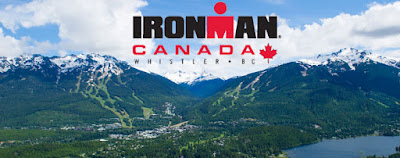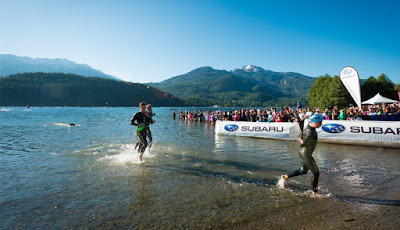Event: 2016 Subaru IRONMAN 70.3 Canada (race website)
Cost: Early bird prices starts at $225 and ramps up to $285 for on-site registration. Withdrawal policy must be received about two months prior to race date, and you're only eligible for a partial refund of $75. Plus, you'll lose all the Active dot com registration fee and tax. I waited until the week prior to sign up mainly because I wasn't sure if I'll be race ready, so I opted to pay about $50 more rather than potentially lose $225 in case of injuries or any unexpected events.
Field size: 520 athletes for the 70.3 in 2016 (1407 athletes for the 140.6).
Sell-out factor: The smaller than usual field was because the race wasn't announced until sometime in March 2016. Most athletes would have already planned out their race season many months ago or even a year in advance. In addition, there were several other races around like Victoria 70.3 was just a few weeks earlier and Calgary 70.3 fell on the same day. I expect that the field for 2017 would be much bigger.
Swim Course: 1-lap wetsuit swim in Alta Lake. The counter-clockwise loop should have been easy to navigate, but I found the buoys are quite far apart from each other, so sometimes I couldn't see spot the next buoy immediately.
Bike Course: 1 loop of rolling hills south to Callaghan, more rolling hills back towards Whistler, long descent with one significant switchback turn north towards Pemberton, and then a monstrous climb back to Whistler Village.
 |
| Note elevation is in metres, not feet |
Run Course: 1 loop. While the elevation chart shows a relatively flat course, the first couple miles have some false flats, making it hard to find the bounce in the legs after the bike leg. The run is mostly shaded with some sun spots near the golf course.
 |
| I wasn't imagining the false flats in the first few km's |
Pre-Race Day Logistics: Check-in is at the Olympic plaza. The nearest parking lot is Marketplace Pavillion. Whistler is super efficient in issuing parking ticket, so overstaying even by a minute is not advisable. The store-front spots have a 30-min limit and the rest of the lot has a 2-hour limit. While you're unlikely to need more than two hours to check in, but if you're planning to do some last-minute shopping and/or get your bike checked, then it is better to park in Lot 4 or 5, just on the other side of the Olympic plaza.
It's a two-transition race where T1 is a couple kilometres from the check-in/T2/finish, so the best advice here is to have your T1 and T2 bags pre-packed and ready to go when you go to check-in. Here's my strategy:
- Pick up race packet
- Drop off T2 bag -- Don't forget to put on your race number, and don't leave any food/drinks because the bears will get into them overnight
- Ride your bike to T1 along with your T1 bag -- This is a nice and easy downhill ride along the valley trail to the lake. All bikes must be checked in the day prior. Put your race numbers on your bike, helmet, and T1 bag. Again, don't leave any food that would attract the bears, and also, don't leave anything expensive (i.e. Garmin bike computer) on your bike. Grapevine has it that someone had his/her Edge 500 stolen out of transition. We had access to our bike and T1 bag on race morning.
- To get back to the village, you have the choice of taking the shuttle, or walk 2km slightly uphill back. The queue for the bus ride was massively long, so we opted to walk. If you have a taper run in your schedule, then this would be a good time to go for a quick run.
Hotels/Accommodations: The question I get the most from friends is "where's the best place to stay in Whistler?", followed by the second most common question: "can I stay with you?" The good news is that summer is less crowded than winter in Whistler, so there won't be any accommodation shortage in July.
I would recommend staying as close to T2 as possible. T2 is the "Parking Lot 5", which is where you will catch the super early morning shuttle to T1. There are lots of hotels to choose from in Whistler Village or Upper Village in Blackcomb. Given it's a ski resort town, there are plenty of accommodations with a kitchen option, which would allow you to cook your own meals during your stay.
Race day transportation: If you stay near the finish line, then you can jump on the early morning shuttles to the start. The last shuttle ends before the full ironman race starts, so even if you're racing the half that starts two hours later, you will still need to catch the early morning shuttle. The roads in and out of the lake will be closed, so don't count on getting dropped off by your loved ones. You could walk down to the lake if you don't mind a couple extra km's to start the day. It's best to just get on one of the later shuttles. Bring food, COFFEE, warm clothes and anything else you need for the long wait at T1.
Aids station: As with other Ironman branded events, the aids stations were well spaced and well stocked.
Spectators: On the bike course, most spectators are gathered around the Whistler Village and the Upper Village entrances, so you will pass by them twice during the first half of the ride. There aren't too many spectators once you head towards Pemberton because the roads are fully closed for a few hours and then partially closed with minimal local traffic later in the day.
On the run, spectators are spread out throughout the course. There were VIP tables and chairs set up through the golf course. As you watch the spectators fine dining and sipping on their wine, you can ask yourself why you're racing.
Swag: Gender-specific tech t-shirt, logo-ed mesh bag with draw string, and medal.
Post-race food/drink: In the finisher’s chute, water and banana. There were burgers, salad and fruits in the post-race food tent.
Pros: A big plus for me is that the bike course is mostly closed to through traffic at least during the peak race hours. Normally the sea-to-sky highway is busy with constant traffic, which makes it unpleasant to do training rides or course preview. The course is challenging just enough that awards patient and good pacing. The run as I mentioned is mostly shaded through the valley trails with good aids station support.
Cons: The super early morning start to catch the shuttles to the lake at least two hours before the half distance race start. The two-transition race adds additional set up time and logistical planning. Weather could be unpredictable in the mountains - freezing rain in 2014. The other risk is bear encounter, disrupting your run until the bears move away from the race path.
Take-home message: Whistler is a beautiful playground for a triathlon event. I love racing the 70.3 while semi-spectating the full ironman. I think I would be back some day (if the race doesn't get cancelled).



No comments:
Post a Comment